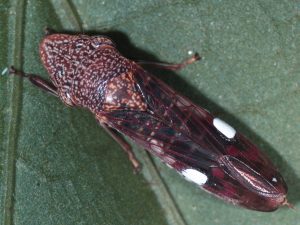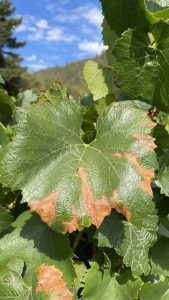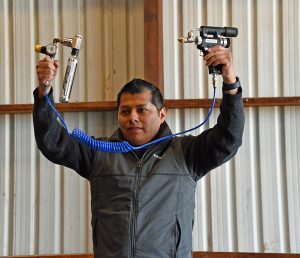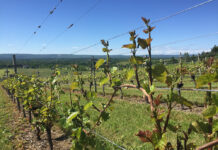
With a dearth of products to manage Pierce’s disease until recently, grape growers instead focused on controlling the insects that spread the disease and removing infected vines.
But federal and California registrations of the biopesticide XylPhi-PD from Palo-Alto-based A&P Inphatec in 2019 gave organic and conventional growers an option that targets Pierce’s disease itself.
The product’s active ingredients are a mix of two bacteriophages, also known as phages, said Josie Hugie, a PCA and consultant to A&P Inphatec. These naturally occurring viruses target and invade specific bacteria, killing them in the process and reproducing more phages. At the same time, they leave other microorganisms, other cells and their hosts unharmed. In the case of PD, the phages target the causal bacterium Xylella fastidiosa.
Ongoing University of California field trials that are examining three naturally occurring bacteria as PD biocontrol agents also are yielding promising results.
The cause for concern is the financial gravity of the disease. In 2014, a UC study estimated Pierce’s disease cost California about $104.4 million per year in vine losses, industry assessments, compliance costs and expenditures by government agencies. Of that, growers bore $56.1 million in lost production and vine replacement expenses.
Texas A&M Research Outcome
Otsuka Pharmaceutical began work for controlling X. fastidiosa in 2007, and in 2010 contacted Carlos Gonzalez, a professor in Texas A&M College of Agriculture and Life Sciences’ Department of Plant Pathology and Microbiology. This led to a collaboration in phage research, which eventually became the first path to isolate phages for X. fastidiosa control.
Gonzalez also is a member of the Texas A&M AgriLife Center for Phage Technology, which is exploring unique therapies to treat bacterial infections of plants, animals and humans.
After conducting extensive greenhouse and field testing, Texas A&M licensed the PD phages to Otsuka Pharmaceutical Co., the parent of A&P Inphatec, to commercialize and market. In addition to being state and federally registered, the product is Organic Materials Review Institute listed for use on certified organic vineyards.

Vine Treatment
Growers inject XylPhi-PD into the xylem using the Pulse Xyleject device that resembles a cattle vaccination gun. The rate depends on the size of the vine. Israel Luna, A&P Inphatect services rep, recommended two injections of 0.08 milliliters each made at the base of the trunk of young vines or replants, staggering the location. For mature vines, he recommended four injections of 0.08 ml each, with two at the base of the trunk and one in each cordon near the trunk.
A 100 ml bottle can treat about 600 young vines or 300 mature vines. Within California, XylPhi-PD is available through Wilbur-Ellis Co. and Helena Agri-Enterprises (except in four counties: Napa, Sonoma, Lake and Mendocino).
Depending on PD pressure, Luna recommended two to three treatments per season spaced four to six weeks apart. The first injection should be given at flowering or 8 to 10 weeks after the vines break dormancy.
“A lot of our current users with blue-green sharpshooter on the coast use it twice per year, but it can be tailored on a case-by-case basis like whether a vineyard has high PD pressure or the vines are near a riparian area,” Hugie said.
But she was quick to point out the bacteriophages are not cure-alls and may not help vines that are too far gone.

“If you’re treating vines that are already infected, you can’t cure them all,” she said. “Tyloses will block the way for the phages. You have to have realistic expectations.”
But in vineyards that had no PD, Hugie said they’ve successfully protected more than 99% of the vines from new disease symptoms.
Since 2019, several trials have been conducted in North Coast vineyards with XylPhi-PD, said Vincent Avila, A&P distributor sales and technical support representative. One set involved three vineyards on the Russian River and one on Dry Creek that had PD hotspots.
In each vineyard, a block was left untreated for the control, one block received treatments for two years (with no treatment in year one) and a third received treatments for three years.

After three years, Avila said they saw a 55% reduction in detectable X. fastidiosa for all vines and an 84% prevention efficacy with no new PD cases in the three-year treated group. There was only one new case in the two-year treated group. Visual symptoms were verified using PCR testing, a type of genetic fingerprinting.
Within these trials, a vineyard with PD found a 17% yield increase in vines treated three years and a 10% yield increase for vines treated two years compared to an untreated control.

Hunt for Other Biocontrol Agents
Dr. Akif Eskalen, a UCCE plant pathology professor, began a field trial near Davis in 2021 testing 10 different treatments. Among them are XylPhi-PD and three different biocontrol bacteria injected individually. In addition, each of the three bacteria were injected in combination with the phages. Of the treatments, only XlyPhi-PD is commercially available and registered for use in California grapes.
Eskalen said he decided to focus on organic and biological agents because synthetic products such as antibiotics are inefficient or not feasible at managing xylem-limiting pathogens.
“It’s very difficult to control a systemic pathogen like Xylella because you need something that’s systemic, and many of the pesticides are not systemic and will not move up and down [the xylem],” he said. “Because of that, we were very limited in trying to find alternate applications.”
Dr. Steve Lindow, professor emeritus with UC Berkeley Department of Plant and Microbial Biology, led a team that identified one of the beneficial bacterium, Paraburkholderia phytofirmans. In previous experiments, it appeared to induce disease resistance in grape plants.
The other two beneficial bacteria were discovered by Dr. Philippe Rolshausen with the UC Riverside Department of Botany and Plant Sciences while analyzing beneficial microbes in non-symptomatic grapevines growing in PD-infected symptomatic vineyards.
Eskalen’s trial is being conducted on 12-year-old Cabernet Franc vines in a vineyard with no history of PD located near the UC Davis campus in Solano County.

Except for the untreated control, all of the grapevines were inoculated with X. fastidiosa May 4, 2022. Depending on the treatment, the biocontrol agents were injected either one day before inoculation and/or seven days after inoculation. He also included a treatment that involved no biocontrol agent.
In August, Eskalen visually rated them for percentage PD foliar symptoms for five straight weeks.
One year into the trial, he called the results “interesting.” Vines treated with three injections of XylPhi-PD following label recommendations had 50% fewer foliar symptoms than the inoculated-only vines.
All three experimental biocontrol agents worked better when combined with XylPhi-PD than they did alone. And a combination of biocontrol agent 1/XylPhi-PD and a combination of biocontrol agent 3/XylPhi-PD performed the best of all treatments.
“This is not 100% control,” Eskalen said. “It’s a significant reduction of the infestation, and we’ve seen a reduction in the symptoms in our one-year trial.”
He emphasized the results are preliminary, and he plans to repeat the trial this year and next to see if the trends continue. But Eskalen said they were too promising not to discuss at least as preliminary findings.

The PD-Sharpshooter Relationship
X. fastidiosa is spread by sharpshooters, a group of leafhoppers that includes blue-green sharpshooters, red-headed sharpshooters and glassy-winged sharpshooters.
As they insert their straw-like stylet to feed in the grapevine’s xylem vessels, or water-conducting tissue, infected sharpshooters inject bacteria. The plants respond with defense mechanisms that include tyloses, which are glue-like substances that dam up vascular tissue to prevent further damage, and gums. Together with the bacteria, they may block the xylem, resulting in wilting and possibly vine death.
During feeding, non-infected sharpshooters also may acquire X. fastidiosa from infected vines that serve as disease reservoirs.
PD symptoms may include marginal leaf scorching, fruit shrivel and “match-sticking” where leaves drop but the petioles remain. Infected plants also may look drought stressed, but a yellow or red-brown band between green and scorched areas on leaves is absent in drought-stressed vines. In addition, symptoms may vary widely, depending on the grape variety and when vines were initially infected.
Blue-green sharpshooters are very efficient vectors of the PD bacterium, but they aren’t strong fliers, said Rodrigo Krugner, a USDA-ARS research entomologist in Parlier. In the North Coast, they frequent riparian areas. As grapevines leaf out, they’ll move into vineyards but typically remain in only the first few rows closest to riparian areas.
Glassy-winged sharpshooters, on the other hand, are not efficient vectors of PD, he said. But they’re strong fliers and have an extensive host range. As a result, PD-infected vines may be found throughout a vineyard.
Pierce’s disease has been reported in California as far back as the 1880s. But it wasn’t until the late 1990s, about 10 years after the glassy-winged sharpshooter arrived in the state likely from the Southeast, that PD began to grab headlines. It turned out the newcomer had the potential to spread X. fastidiosa much farther and faster than native sharpshooters.
Currently, glassy-winged sharpshooters are found mainly in Southern California and the southern San Joaquin Valley.






